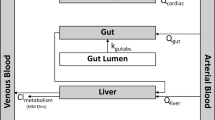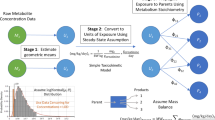Abstract
Physiologically based pharmacokinetic (PBPK) modeling is a well-established toxicological tool designed to relate exposure to a target tissue dose. The emergence of federal and state programs for environmental health tracking and the availability of exposure monitoring through biomarkers creates the opportunity to apply PBPK models to estimate exposures to environmental contaminants from urine, blood, and tissue samples. However, reconstructing exposures for large populations is complicated by often having too few biomarker samples, large uncertainties about exposures, and large interindividual variability. In this paper, we use an illustrative case study to identify some of these difficulties, and for a process for confronting them by reconstructing population-scale exposures using Bayesian inference. The application consists of interpreting biomarker data from eight adult males with controlled exposures to trichloroethylene (TCE) as if the biomarkers were random samples from a large population with unknown exposure conditions. The TCE concentrations in blood from the individuals fell into two distinctly different groups even though the individuals were simultaneously in a single exposure chamber. We successfully reconstructed the exposure scenarios for both subgroups — although the reconstruction of one subgroup is different than what is believed to be the true experimental conditions. We were however unable to predict with high certainty the concentration of TCE in air.
This is a preview of subscription content, access via your institution
Access options
Subscribe to this journal
Receive 6 print issues and online access
$259.00 per year
only $43.17 per issue
Buy this article
- Purchase on Springer Link
- Instant access to full article PDF
Prices may be subject to local taxes which are calculated during checkout






Similar content being viewed by others
References
Blancato J., Power F., Fisher J. and Kantor E . Application and use of dose estimating exposure model (DEEM) for dose comparisons after exposure to trichloroethylene (TCE). 39th Annual Meeting, Society of Toxicology, Philadelphia, PA, March 19–23, 2002.
Bogen K.T. and Spear R.C . Integrating uncertainty and interindividual variability in environmental risk assessment. Risk Anal 1987: 7(4): 427–436.
Box G.E.P. and Tiao G.C . Bayesian Inference in Statistical Analysis. Wiley Classics, New York, 1973.
Bois F.Y., Gelman A., Jiang J., Maszle D.R., Zeise L. and Alexeef G . Population toxicokinetics of tetrachloroethylene. Arch Toxicol 1996a: 70: 347–355.
Bois F.Y., Jackson E.T., Pekari K. and Smith M.T . Population toxicokinetics of benzene. Environ Health Persp 1996b: 104: 1405–1411.
Bois F.Y . Applications of population approaches in toxicology. Toxicol Lett 2001: 120: 385–394.
Brand K.P. and Small M.J . Updating uncertainty in an integrated risk assessment — conceptual framework and methods. Risk Anal 1995: 15(6): 719–731.
Brown P.N., Byrne G.D. and Hindmarsh A.C . VODE, a variable-coefficient ODE solver. SIAM J Sci Stat Comput 1989: 10(5): 1038–1051.
Castorina R., Bradman A., McKone T.E., Barr D.B., Harnly M.E. and Eskenazi B . Assessing cumulative organophosphate pesticide exposure and risk among pregnant women living in an agricultural community. Environ Health Persp 2002; submitted.
Centers for Disease Control and Prevention (CDC). National report on human exposure to environmental chemicals. Published by and available from the Centers for Disease Control and Prevention, National Center for Environmental Health, division of Laboratory Sciences, Atlanta, GA, 2001, www.cdc.gov/nceh/dls/report.
Chinnery R. and Gleason K . A compartment model for the prediction of breath concentration and absorbed dose of chloroform after exposure while showering. Risk Anal 1993: 13: 51–62.
Dakins M.E., Toll J.E., Small M.J. and Brand K.P . Risk-based environmental remediation --- Bayesian Monte Carlo analysis and the expected value of sample information. Risk Anal 1996: 16(1): 67–79.
Finkel A.M. and Evans J.S. Evaluating the benefits of uncertainty reduction in environmental health risk management. JAPCA 1987: 37: 1164–1171.
Fisher J . Physiologically based pharmacokinetic models for trichloroethylene and its oxidative metabolites. An EPA report draft 2, April 7, 1998 from the Operational Toxicology branch, Human Effectiveness directorate, Wright–Patterson AFB, OH 45433, 1998.
Gargas M.L., Burgess R.J., Voisard D.E., Cason G.H. and Andersen M.E . Partition coefficients of low-molecular weight volatile chemicals in various liquids and tissues. Toxicol Appl Pharmacol 1989: 98: 87–99.
Gelman A., Bois F.Y. and Jiang J . Physiological pharmacokinetic analysis using population modeling and informative prior distributions. J. Am Stat Associ 1996: 91: 1400–1412.
Gelman A., Carlin J.B., Stern H.S. and Rubin D.B . Bayesian Data Analysis. Chapman & Hall/CRC, Boca Raton, FL, 1995.
Jo W.K., Weisel C.P. and Lioy P.J . Chloroform exposure and body burden from showering with chlorinated tap water. Risk Anal 1990: 10: 575–580.
Klaassen C.D . Distribution, excretion and absorption of toxicants. In: Klaassen C. D., Amdur M. O., and Doul J. (Eds.). Cassarett and Doul's Toxicology, the Basic Science of Poisons. Pergamon Press, New York, NY, 1996, pp. 33–63.
McKone T.E . Linking a PBPK model for chloroform with measured breath concentrations in showers: implications for dermal exposure models. J Expos Anal Environ Epidemiol 1993: 3: 339–365.
McKone T.E. and Daniels J.I. Estimating human exposure through multiple pathways from air, water, and soil. Regul Toxicol Pharmacol 1991: 13: 36–61.
Morgan M.G. and Henrion M . Uncertainty: A Guide to Dealing with Uncertainty in Quantitative Risk and Policy Analysis. Cambridge University Press, New York, NY, 1990.
Pinsky P.F. and Lorber M.N . A model to evaluate past exposure to 2,3,7,8-TCDD. J Expos Anal Environ Epidemiol 1998: 8(2): 187–206.
Ramsey J.C. and Andersen M.E . A physiologically-based description of the inhalation pharmacokinetics of styrene in rats and humans. Toxicol Appl Pharmacol 1984: 73: 159–175.
Roy A. and Georgopoulos P.G . Reconstructing week-long exposures to volatile organic compounds using physiologically based pharmacokinetic models. J Expos Anal Environ Epidemiol 1998: 8(3): 407–422.
Sexton K., Kleffman D.E. and Callahan M.A . An introduction to the National Human Exposure Assesment Survey (NHEXAS) and related Phase I Field Studies. J Expos Anal Environ Epidemiol 1995: 5: 3229–3232.
Sohn M.D., Small M.J. and Pantazidou M . Reducing uncertainty in site characterization using Bayes Monte Carlo methods. J Environ Engi — ASCE 2000: 126(10): 893–902.
Spear R.C. and Bois F.Y . Parameter variability and the interpretation of physiologically based pharmacokinetic modeling results. Environ Health Persp 1994: 102(11): 61–66.
Small M.J. and Fischbeck P.S . False precision in Bayesian updatng with incomplete models. Hum Ecol Risk Assess 1999: 5(2): 291–301.
Taylor A.C., Evans J.S. and McKone T.E. The value of animal test information in environmental control decisions. Risk Anal 1993: 13(4): 403–412.
US Environmental Protection Agency (USEPA). Exposure and Human Health Reassessment of 2,3,7,8-Tetrachlorodibenzo-p-Dioxin (TCDD) and Related Compounds. (DRAFT). Rpt No. EPA/600/P-001, US Environmental Protection Agency Office of Research and Development, National Center for Environmental Assessments, Washington, DC, 2001. Report available at: http://www.epa.gov/ncea/dioxin.htm.
US Environmental Protection Agency (USEPA). Risk Assessment Guidance for Superfund. Volume I. Human Health Evaluation Manual (Part A).US Environmental Protection Agency, Office of Emergency and Remedial Response. Washington, DC, 1989. EPA/540/1-89/002.
US Environmental Protection Agency (USEPA). Environmental Protection Agency, Guidelines for Exposure Assessment: Notice. Federal Register 1992: 57(104): 22888–22938.
US Environmental Protection Agency (USEPA). Children's total exposure to persistent pesticides and other persistent organic pollutants (CTEPP). US Environmental Protection Agency, National Exposure Research Laboratory, Research Triangle Park, NC, 2002.
Vicini P., Pierce C.H., Dills R.L., Morgan M.S. and Kalman D.A. Individual prior information in a physiological model of 2H8-toluene kinetics: an empirical Bayes estimation strategy. Risk Anal 1999: 19(6): 1127–1134.
Wakefield J. The Bayesian analysis of population pharmacokinetic models. J Am Stat Assoc 1996: 91(433): 62–75.
Wallace L.A . Human exposure and body burden for chloroform and other trihalomethanes. Crit Rev Environ Sci Technol 1997: 27(2): 113–194.
Wallace L.A. and Pellizzari E.D. Recent advances in measuring exhaled breath and estimating exposure and body burden for volatile organic compounds (VOCs). Environ Health Persp 1995: 103: 95–98.
Weisberg S., Applied Linear Regression, 2nd ed. John Wiley & Sons, NY.
Zartarian V.G., Ott W.R. and Duan N.H. A quantitative definition of exposure and related concepts. J Expos Anal Environ Epidemiol 1997: 7(4): 411–437.
Acknowledgements
This work was supported in part by the US Environmental Protection Agency National Exposure Reasearch Laboratory through Interagency Agreement # DW-988-38190-01-0 and carried out at Lawrence Berkley National Laboratory through the US Department of Energy under contract Grant No. DE-AC03-76SF00098. This work was also supported in part by the Health Tracking Center of Excellence at the University of California Berkley, and funded by interagency agreement No. U50CCUT922409-01 with US Centers for Disease Control. We thank M. Rigas and F.Power from the US EPA for their help in developing the PBPK model. We also thank M.Macleod, W.Riley, and the reviewers for their helpful comments on an earlier version of this manuscript.
Author information
Authors and Affiliations
Corresponding author
Additional information
The United States Environmental Protection Agency through its Office of Research and Development funded and collaborated in the research described here under Interagency Assistance Agreement to Lawrence Berkeley National Laboratory (IAG #89938190). It has been subjected to Agency review and approved for publication.
Rights and permissions
About this article
Cite this article
Sohn, M., McKone, T. & Blancato, J. Reconstructing population exposures from dose biomarkers: inhalation of trichloroethylene (TCE) as a case study. J Expo Sci Environ Epidemiol 14, 204–213 (2004). https://doi.org/10.1038/sj.jea.7500314
Received:
Accepted:
Published:
Issue Date:
DOI: https://doi.org/10.1038/sj.jea.7500314
Keywords
This article is cited by
-
Alternative (non-animal) methods for cosmetics testing: current status and future prospects—2010
Archives of Toxicology (2011)
-
A Bayesian population PBPK model for multiroute chloroform exposure
Journal of Exposure Science & Environmental Epidemiology (2010)
-
Public health interpretation of trihalomethane blood levels in the United States: NHANES 1999–2004
Journal of Exposure Science & Environmental Epidemiology (2010)
-
Exposure estimation using repeated blood concentration measurements
Stochastic Environmental Research and Risk Assessment (2010)
-
Exposure information in environmental health research: Current opportunities and future directions for particulate matter, ozone, and toxic air pollutants
Journal of Exposure Science & Environmental Epidemiology (2009)



